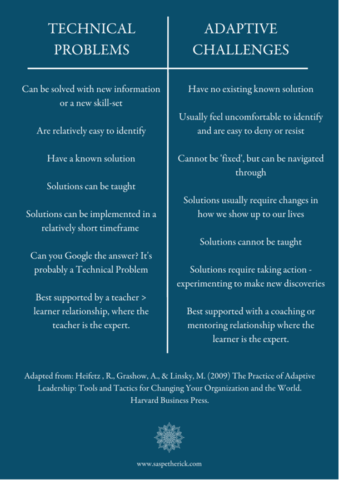11
Nov 2019
Adaptable and Adaptive: Two Great but Distinct Leadership Concepts
WGF/DS Alum Dr. Tali Zelkowicz (Class 15)
Although adaptability and adaptive leadership share a root or shoresh, and although you will see both addressed by authors in this issue of WexnerLEADS, the two are not synonymous.
Adaptability is one component in a constellation of interdependent leadership (and life) skills. Judaism, for example, has been adaptable. It has also remained rooted in significant ways so that it still makes sense to call it Judaism, 2,000 years of change later. While Adaptability is being able to adjust to new conditions and about having the capacity to be modified for a new use or purpose, Adaptive Leadership allows us to create new conditions, not only adjust to external ones. Both are essential for becoming a potent change agent, but they sometimes get conflated, which can compromise both.
Adaptability
A Gumby toy is stretchable, apparently some even up to 48 inches, and I’ve never seen anyone break him. Water moves freely through every crack and crevice and can carve into stone and create structures that endure for thousands of millennia. The 16th century Italian Jewish commentator Obadiah Sforno is known, in part, for his metaphor urging those under threat and challenge to bend like a reed instead of trying to stand tall like a cedar (and risk destruction).
These are all examples of the power and strength that come from being adaptable. Many scholars and communal leaders have argued (historians chief among them) that Jewish tradition has survived precisely because of its adaptability. At the same time, there isn’t anything like a simple, straightforward line to be drawn from being able to adapt to new realities and guaranteed survival. In fact, the questions of if, how much and what counts as legitimate adaptability have become a loaded if not outright explosive debate, with nothing less at stake than whose expressions of Jewish life and practice will prove generative (and secure our survival) and whose will not.
These politics of authenticity exist among Jewish leaders across every sector and have intensified, particularly since the 1990s, when the Jewish Continuity Crisis was first declared. Three decades into the Crisis later – coinciding with almost the same three decades of The Wexner Foundation – with every passing minute it has become clearer to me that we need to live in and embrace the tension between “change as good or normal” and “change as loss,” as a vital and productive paradox. It would be such a fruitful shift, for example, if we could think in terms of what Wexner Israel Fellow Alum, Gidi Grinstein, (Class 13), has referred to in his book of the same title, Flexigidity. (1)
The word flexigidity does linguistically what leadership experts want us to be brave enough to do in practice: to “dance on the edge” of multiple, equal and often competing values. What would it take for us to get better at responding to challenging realities both through lenses of cultural authority that mark “survivalist-traditionalist” stances (commitment to canons of content and practices deemed essential for Jewish survival when faced with change) and lenses of cultural fluidity that mark “transformationist” stances (considering Jewish content and practices adaptable as a strategy for responding to change). When we approach a challenge that makes us uncomfortable, does not have a known solution or formula and that requires active experimentation to make new discoveries, we have entered the realm of adaptive leadership.
Adaptive Leadership: A Refresher
Judaism has been adaptable and flowed like water through millennia of dramatic changes, able to bend and pivot flexibly in response to externally changing conditions. At the same time, Judaism has also been able to be adaptive and cause change in the world, creating new ways of thinking, offering distinct value orientations, shaping the larger world in diverse ways, from art to theology. The difference has to do with navigating change versus enacting change.
It may have been weeks, months or even years since you learned about Adaptive Leadership with a Wexner program. The Wexner Foundation staff have been teaching and learning Adaptive Leadership for two decades and regularly revisits how best to do it. Adaptive Leadership,(2) as we know especially in the Wexner community, is a 20-year-old and still evolving model of leadership practice that makes us think of those critical trips to our proverbial balconies. It’s also so much more than that. This year we are taking a focused dive into how we teach and learn about Adaptive Leadership and we look forward to sharing what we discover. In the meantime, here is a refresher that focuses on what we believe are concepts that have enduring value.
Similar to the field of “Adaptive Sports,” which thoughtfully and deliberately changes both the gear and even the rules of a sport to empower everyone to be able to participate and excel in a sport, Adaptive Leadership seeks to empower leaders to bring about positive change in exceedingly complex, ever shifting and ultimately dangerous landscapes filled with uncertainty and ambiguity. Marty Linsky,(3) one of the founding thinkers and authors of many books on Adaptive Leadership, refers to it as “an experiment in conflict.” Indeed, the counterintuitive and countercultural goal is to orchestrate conflict, rather than resolve or eliminate it.
Adaptive leaders embrace the reality that conflict is the norm not the exception in the activity that is leadership. Adaptive leaders learn how to keep their hand on the metaphorical thermostat and find what Linsky calls, “that sweet spot where innovation flows.” To get there, it can’t be too “hot,” that is, too threatening or loss-inducing, and it can’t be too “cold,” that is, unstimulating or unreflectively supportive of the status quo. Ultimately, Linsky defines Adaptive Leadership as “disappointing one’s own people at a rate at which they can absorb,” and as a “distribution of loss.” And that, Linsky breaks it to us, means we are all in the grief counseling business because we are helping people think about things they usually prefer to avoid.
Managing loss is at the heart of Adaptive Leadership. Acknowledging that goes a long way toward explaining why successful leadership can feel so exhausting, scary, dangerous and why too few people manage to do it well or seek to do it at all. You can hear Marty elaborate further here about what makes Adaptive Leadership dangerous and why we don’t do it more often than we do.
Perhaps the most surprising insight that comes from research on Adaptive Leadership is that we only spend about 10% of our time doing adaptive work. The other 90% of our time is spent on “technical work;” that is, problems that can be solved with predetermined tools or knowledge, can be executed quickly and are easier to identify in the first place. In other words, it is during that critical tenth of our leadership activity where we are engaged in the kind of leadership work that moves the needle and facilitates true change.
 While it might sound a lot more sane and certainly more inspiring to describe what we do as striving to transform our congregations, our organizations, our boards or to reinvent our schools and camps, to innovate and imagine new entities that don’t even exist yet, or to heal the world, there is another response we could give as adaptive leaders. If we’re being really honest, here’s what we could say we do: “Every day I go to work and I ask people to give up something that is important to them, that they’ve relied on in the past, possibly very heavily and for a long time.”
While it might sound a lot more sane and certainly more inspiring to describe what we do as striving to transform our congregations, our organizations, our boards or to reinvent our schools and camps, to innovate and imagine new entities that don’t even exist yet, or to heal the world, there is another response we could give as adaptive leaders. If we’re being really honest, here’s what we could say we do: “Every day I go to work and I ask people to give up something that is important to them, that they’ve relied on in the past, possibly very heavily and for a long time.”
But when we do do it, it’s because that is how we bring about change that can heal, improve, repair, sophisticate, engage, solve, deepen and so much more. I also think we dare to do it when we are not alone. When we have each other, it is not as scary, lonely, or exhausting. Indeed, adaptive leadership can be exhilarating, empowering and ideally, contagious. We take the risks involved in adaptive leadership because that’s where all the possibilities and potential for our better futures lie.
Recommended Sources on Adaptive Leadership
Heifetz, Ronald, Alexander Grashow, Marty Linsky (2009), The Practice of Adaptive Leadership: Tool and Tactics for Changing Your Organization and the World. Boston, MA: Harvard University Press.
Heifetz, Ronald (1994), Leadership Without Easy Answers. Boston, MA: Harvard University Press.
Additional Notes:
- Grinstein, Gidi. (2013) Flexigidity: The Secret of Jewish Adaptability & Challenge and Opportunity Facing Israel. Israel and USA: self-published.
- In case you want a quick overview, here is a surprisingly comprehensive and refreshingly visual video that explains Adaptive leadership in less than 4 minutes.
- Marty Linsky was Co-Founder of Cambridge Leadership Associates and has been on the faculty of the Harvard Kennedy School for over 30 years and has also taught in and consulted to The Wexner Foundation for two decades. He is the author of many books and chapters, including Leveling the Playing Field (2008), co-authored with Shifra Bronznick and Didi Goldenhar and The Practice of Adaptive Leadership (Harvard Business Press 2009), co-authored with Ronald Heifetz and Alexander Grashow.


Get To Know The Author
Wexner Graduate Fellow Alum Dr. Rabbi Tali Zelkowicz (Class 15) is the Director of Curriculum and Research for The Wexner Foundation. She has a BA in sociology from the University of British Columbia (1995), an MA in Jewish Education from the Rhea Hirsch School of Education (RHSOE) at Hebrew Union College-Jewish Institute of Religion, Los Angeles (2000), and was ordained at HUC-JIR, Los Angeles (2002). She has a PhD in Educational Sociology from New York University.

